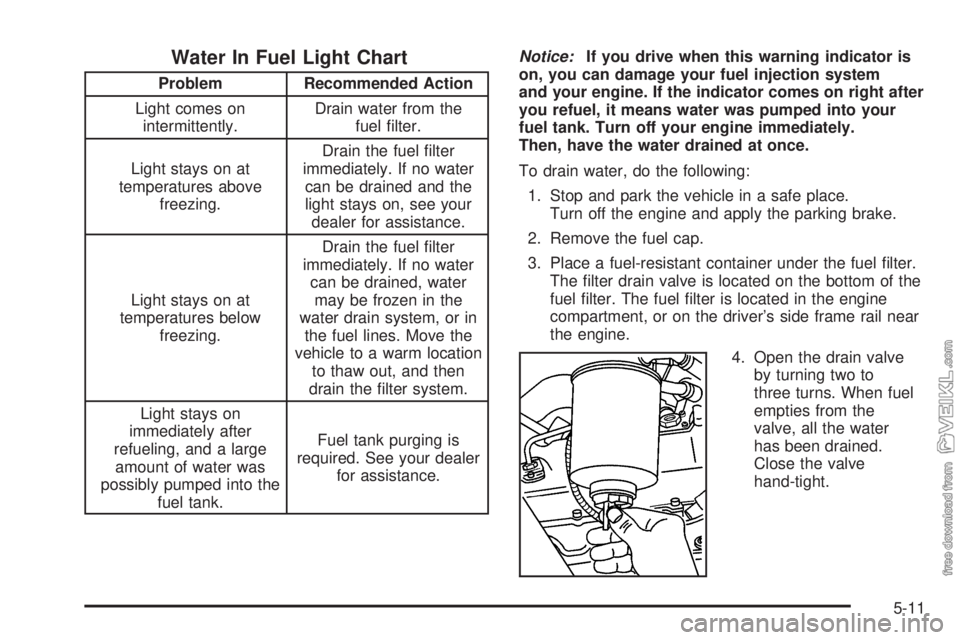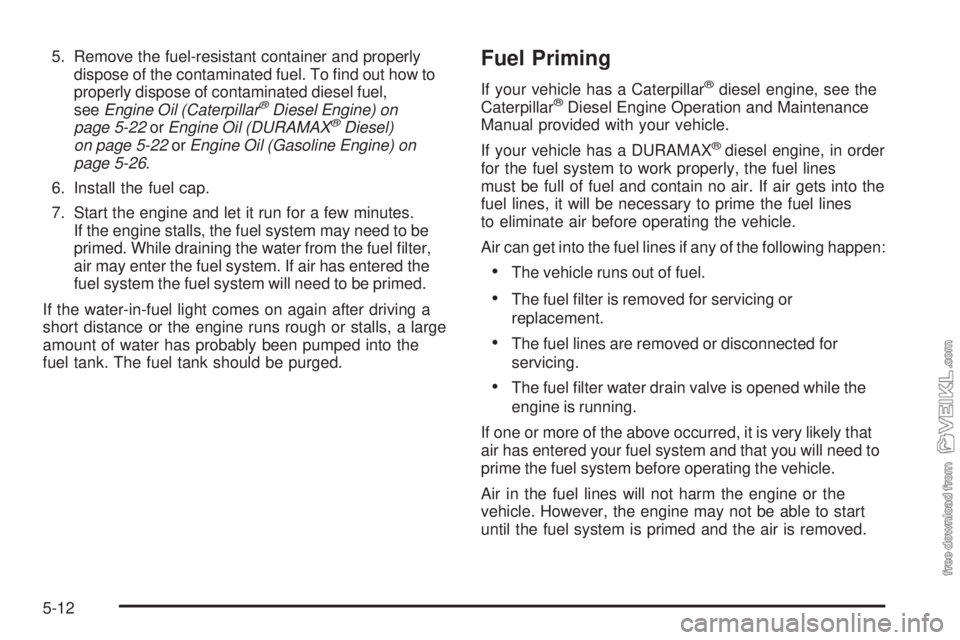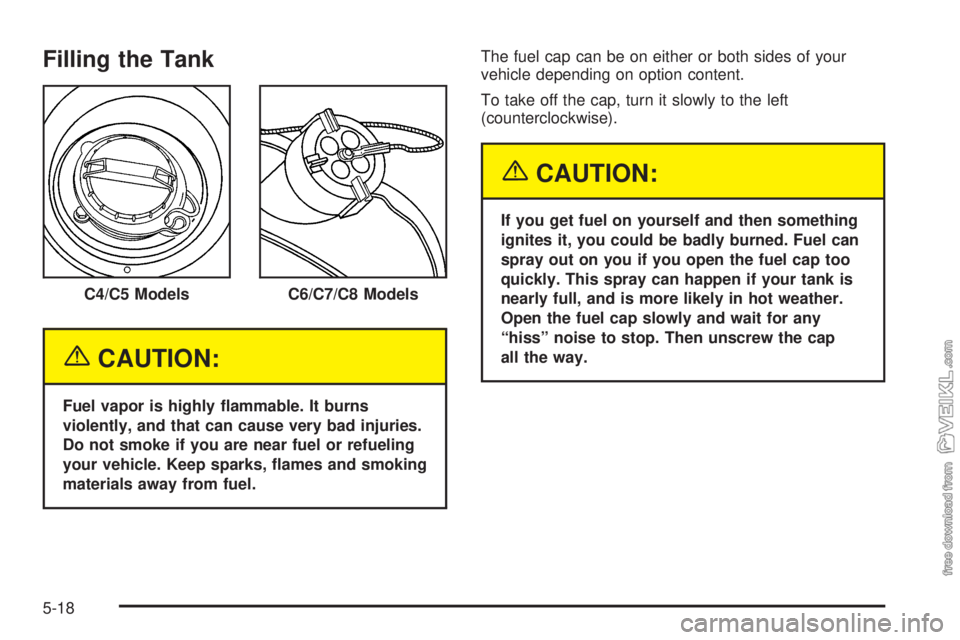2005 CHEVROLET KODIAK fuel cap
[x] Cancel search: fuel capPage 1 of 374

Seats and Restraint Systems........................... 1-1
Front Seats
............................................... 1-2
Rear Seats
............................................... 1-8
Safety Belts
.............................................. 1-9
Child Restraints
.......................................1-27
Airbag System
.........................................1-48
Restraint System Check
............................1-60
Features and Controls..................................... 2-1
Keys
........................................................ 2-2
Doors and Locks
....................................... 2-6
Windows
.................................................. 2-8
Starting and Operating Your Vehicle
...........2-11
Mirrors
....................................................2-45
Storage Areas
.........................................2-47
Instrument Panel............................................. 3-1
Instrument Panel Overview
.......................... 3-4
Climate Controls
......................................3-20
Warning Lights, Gages, and Indicators
........3-24
Audio System(s)
.......................................3-44
Driving Your Vehicle....................................... 4-1
Your Driving, the Road, and Your Vehicle
..... 4-2
Towing
...................................................4-35Service and Appearance Care.......................... 5-1
Service
..................................................... 5-3
Fuel
......................................................... 5-6
Checking Things Under the Hood
...............5-20
Rear Axle
...............................................5-60
Four-Wheel Drive
.....................................5-62
Front Axle
...............................................5-63
Noise Control System
...............................5-64
Bulb Replacement
....................................5-65
Windshield Wiper Blade Replacement
.........5-65
Other Service Items
..................................5-66
Tires
......................................................5-70
Appearance Care
.....................................5-79
Vehicle Identification
.................................5-87
Electrical System
......................................5-88
Capacities and Specifications
.....................5-95
Normal Maintenance Replacement Parts
....5-100
Maintenance Schedule..................................... 6-1
Maintenance Schedule
................................ 6-2
Customer Assistance and Information.............. 7-1
Customer Assistance and Information
........... 7-2
Reporting Safety Defects
............................ 7-7
Index................................................................ 1
2005 Chevrolet Kodiak Owner ManualM
Page 135 of 374

)(Bi-Level):This mode directs half of the air to the
instrument panel vents, then directs the remaining
air to the floor vents. Cooler air is directed to the upper
vents and warmer air to the floor vents.
6(Floor):This mode directs most of the air to the
floor vents. Use this mode to send air to the rear of the
vehicle. Keep the area under the front seats free of
objects that could obstruct airflow to the rear of
the vehicle.
The mode knob can also be used to select the defrost
mode. For more information, see “Defogging and
Defrosting” later in this section.
9(Fan):Turn the left knob clockwise or
counterclockwise to increase or decrease the fan speed.
To increase airflow, turn the knob clockwise. To
decrease airflow, turn it counterclockwise. To turn the
fan off, turn the mode knob on the far right
counterclockwise to the off position.
Temperature Knob:Turn the middle knob located
clockwise or counterclockwise to increase or decrease
the temperature inside of your vehicle. Turn the
knob toward the red area for warmer air. Turn the knob
toward the blue area for cooler air.If your vehicle has air conditioning, the controls will look
like this:
On hot days, open the windows to let hot inside air
escape; then close them. This helps to reduce the time
it takes for your vehicle to cool down. It also helps
the system to operate more efficiently.
<(Maximum Air Conditioning):Turn the right knob
to this setting for maximum cooling. This setting puts
the system in recirculation mode and helps to maximize
your air conditioner’s performance and your vehicle’s
fuel economy. This setting also cools the air the fastest.
Y(Air Conditioning):This setting is used for
normal cooling on hot days. It cools outside air and
directs it through the instrument panel vents.
)(Bi-Level Air Conditioning):This setting divides
airflow between the floor vents and instrument panel
vents. The air conditioning compressor will cycle
continuously in this setting as long as the outside
temperature is warm enough to activate the compressor.Vehicles With Air Conditioning
3-21
Page 206 of 374

Loading Your Vehicle
There is a vehicle specific GVW Rating label on your
vehicle that shows how much weight it may properly
carry. It also shows the size of your original tires and the
inflation pressures needed to obtain the gross weight
capacity of your vehicle. This is called the Gross Vehicle
Weight Rating (GVWR).
The GVWR includes the weight of the vehicle, all
occupants, fuel and cargo.The GVW Rating label is provided by the final
manufacturer and should be on the door or door jamb.
It also tells you the maximum weights for the front
and rear axles, called Gross Axle Weight Rating
(GAWR). To find out the actual loads on your front and
rear axles, you need to go to a weigh station and
weigh your vehicle. Your dealer can help you with this.
Be sure to spread out your load equally on both
sides of the center line.
Never exceed the GVWR for your vehicle, or the GAWR
for either the front or rear axle.
And, if you do have a heavy load, you should spread
it out.
4-32
Page 213 of 374

Service............................................................5-3
Doing Your Own Service Work.........................5-4
Two Safety Cautions about Engine Fan
Breakage...................................................5-5
Fuel................................................................5-6
Gasoline Octane............................................5-6
Gasoline Specifications....................................5-6
Additives.......................................................5-6
Diesel Engine Fuel.........................................5-7
What Fuel to Use...........................................5-8
Very Cold Weather Operation.........................5-10
Water in Fuel...............................................5-10
Running Out of Fuel.....................................5-15
Fuel Filter Replacement.................................5-16
Fuels in Foreign Countries.............................5-17
Filling the Tank............................................5-18
Filling a Portable Fuel Container.....................5-19
Checking Things Under the Hood....................5-20
Hood Latches...............................................5-20
Engine Oil (Caterpillar
®Diesel Engine).............5-22
Engine Oil (DURAMAX®Diesel)......................5-22
Engine Oil (Gasoline Engine)..........................5-26
Engine Oil Life System (Gasoline Engine)........5-29
Engine Oil Life System (DURAMAX
®Diesel).....5-31
Engine Oil Life System (Caterpillar®
Diesel Engine)..........................................5-32Engine Air Cleaner/Filter................................5-33
Automatic Transmission Fluid.........................5-34
Manual Transmission Fluid.............................5-35
Engine Coolant (Gas and
DURAMAX
®Engines).................................5-36
Engine Coolant (Caterpillar®Diesel Engines).....5-38
Coolant Surge Tank Pressure Cap..................5-38
Engine Overheating.......................................5-38
Cooling System (Gas and
DURAMAX
®Engines).................................5-40
Engine Fan Noise.........................................5-45
Power Steering Fluid.....................................5-45
Windshield Washer Fluid................................5-46
Brakes........................................................5-47
Battery........................................................5-55
Jump Starting...............................................5-56
Rear Axle.......................................................5-60
Rear Axle Shift Motor....................................5-62
Four-Wheel Drive............................................5-62
Front Axle......................................................5-63
Noise Control System.....................................5-64
Tampering with Noise Control System
Prohibited.................................................5-64
Bulb Replacement..........................................5-65
Windshield Wiper Blade Replacement..............5-65
Section 5 Service and Appearance Care
5-1
Page 214 of 374

Other Service Items........................................5-66
Fuel Filter....................................................5-66
Primary Fuel Filter and Water Separator..........5-67
Secondary Fuel Filter and Water Separator/
Heater (Caterpillar
®Diesel)..........................5-68
Automatic Ether Injection System
(Caterpillar
®Diesel)....................................5-68
Front Wheel Bearings with Oil-Filled Hubs........5-69
Air Conditioning System.................................5-70
Tires..............................................................5-70
Inflation - Tire Pressure.................................5-71
Wheel Loading.............................................5-71
Dual Tire Operation.......................................5-72
When It Is Time for New Tires.......................5-72
Wheel Alignment and Tire Balance..................5-73
Tightening the Wheel Nuts.............................5-73
Wheel Replacement......................................5-77
If a Tire Goes Flat........................................5-78
Appearance Care............................................5-79
Cleaning the Inside of Your Vehicle.................5-80
Fabric/Carpet...............................................5-81
Instrument Panel, Vinyl, and Other
Plastic Surfaces........................................5-82
Care of Safety Belts......................................5-82
Weatherstrips...............................................5-82Washing Your Vehicle...................................5-83
Cleaning Exterior Lamps/Lenses.....................5-83
Finish Care..................................................5-83
Windshield and Wiper Blades.........................5-84
Aluminum or Chrome-Plated Wheels................5-84
Tires...........................................................5-85
Sheet Metal Damage.....................................5-85
Finish Damage.............................................5-85
Underbody Maintenance................................5-85
Chemical Paint Spotting.................................5-85
Vehicle Identi�cation......................................5-87
Vehicle Identification Number (VIN).................5-87
Service Statement.........................................5-87
Service Parts Identification Label.....................5-88
Electrical System............................................5-88
Add-On Electrical Equipment..........................5-88
Headlamp Wiring..........................................5-88
Windshield Wiper Fuses................................5-88
Fusible Links................................................5-89
Power Windows and Other Power Options.......5-89
Fuses and Circuit Breakers............................5-89
Instrument Panel Fuse Block..........................5-89
Underhood Fuse Block..................................5-92
Capacities and Speci�cations..........................5-95
Normal Maintenance Replacement Parts.........5-100
Section 5 Service and Appearance Care
5-2
Page 223 of 374

Water In Fuel Light Chart
Problem Recommended Action
Light comes on
intermittently.Drain water from the
fuel filter.
Light stays on at
temperatures above
freezing.Drain the fuel filter
immediately. If no water
can be drained and the
light stays on, see your
dealer for assistance.
Light stays on at
temperatures below
freezing.Drain the fuel filter
immediately. If no water
can be drained, water
may be frozen in the
water drain system, or in
the fuel lines. Move the
vehicle to a warm location
to thaw out, and then
drain the filter system.
Light stays on
immediately after
refueling, and a large
amount of water was
possibly pumped into the
fuel tank.Fuel tank purging is
required. See your dealer
for assistance.Notice:If you drive when this warning indicator is
on, you can damage your fuel injection system
and your engine. If the indicator comes on right after
you refuel, it means water was pumped into your
fuel tank. Turn off your engine immediately.
Then, have the water drained at once.
To drain water, do the following:
1. Stop and park the vehicle in a safe place.
Turn off the engine and apply the parking brake.
2. Remove the fuel cap.
3. Place a fuel-resistant container under the fuel filter.
The filter drain valve is located on the bottom of the
fuel filter. The fuel filter is located in the engine
compartment, or on the driver’s side frame rail near
the engine.
4. Open the drain valve
by turning two to
three turns. When fuel
empties from the
valve, all the water
has been drained.
Close the valve
hand-tight.
5-11
Page 224 of 374

5. Remove the fuel-resistant container and properly
dispose of the contaminated fuel. To find out how to
properly dispose of contaminated diesel fuel,
seeEngine Oil (Caterpillar
®Diesel Engine) on
page 5-22orEngine Oil (DURAMAX®Diesel)
on page 5-22orEngine Oil (Gasoline Engine) on
page 5-26.
6. Install the fuel cap.
7. Start the engine and let it run for a few minutes.
If the engine stalls, the fuel system may need to be
primed. While draining the water from the fuel filter,
air may enter the fuel system. If air has entered the
fuel system the fuel system will need to be primed.
If the water-in-fuel light comes on again after driving a
short distance or the engine runs rough or stalls, a large
amount of water has probably been pumped into the
fuel tank. The fuel tank should be purged.
Fuel Priming
If your vehicle has a Caterpillar®diesel engine, see the
Caterpillar®Diesel Engine Operation and Maintenance
Manual provided with your vehicle.
If your vehicle has a DURAMAX
®diesel engine, in order
for the fuel system to work properly, the fuel lines
must be full of fuel and contain no air. If air gets into the
fuel lines, it will be necessary to prime the fuel lines
to eliminate air before operating the vehicle.
Air can get into the fuel lines if any of the following happen:
•The vehicle runs out of fuel.
•The fuel filter is removed for servicing or
replacement.
•The fuel lines are removed or disconnected for
servicing.
•The fuel filter water drain valve is opened while the
engine is running.
If one or more of the above occurred, it is very likely that
air has entered your fuel system and that you will need to
prime the fuel system before operating the vehicle.
Air in the fuel lines will not harm the engine or the
vehicle. However, the engine may not be able to start
until the fuel system is primed and the air is removed.
5-12
Page 230 of 374

Filling the Tank
{CAUTION:
Fuel vapor is highly �ammable. It burns
violently, and that can cause very bad injuries.
Do not smoke if you are near fuel or refueling
your vehicle. Keep sparks, �ames and smoking
materials away from fuel.The fuel cap can be on either or both sides of your
vehicle depending on option content.
To take off the cap, turn it slowly to the left
(counterclockwise).
{CAUTION:
If you get fuel on yourself and then something
ignites it, you could be badly burned. Fuel can
spray out on you if you open the fuel cap too
quickly. This spray can happen if your tank is
nearly full, and is more likely in hot weather.
Open the fuel cap slowly and wait for any
“hiss” noise to stop. Then unscrew the cap
all the way. C4/C5 Models
C6/C7/C8 Models
5-18